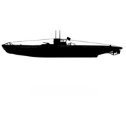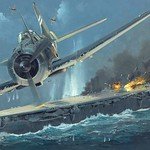Search the Community
Showing results for tags 'U-Boot'.
-
Hello My next U-Boot in 1:72 scale from Das Werk. Enjoy.
- 10 replies
-
- 26
-

-

-
U Boat Type VIIC Das Boot Collectors Edition 1:144 Revell (05675) The Type VII submarine was based on earlier German designs. This type would go onto become the most used German submarines of WWII with over 700 being built. As with anything there would be many modifications along the way. The type started as the V11A with an initial 10 being built. The type VIIC would become the main boat of the German Navy with 568 being built between 1940 and 1945. With a range of 8500 nautical miles. The boats had 4 forward, and one stern tube in general (there were a few exceptions) with 14 torpedoes being carried. For surface running and battery charging a pair of supercharged 6 cylinder 4 stroke diesel engines were used which gave a top speed of 17.7 knots. A maximum submerged speed of 7.6 knots was possible with a new fully charged battery. The submarines generally carried a crew of 44 to 52 men in what can best be described as "cramped" conditions. Most people will be familiar with the Type VIIC from the original "Das Boot" film where U-96 was this type. The film by Wolfgang Petersen was nominated for two Academy awards and was based on the book by Lothar-Günther Buchheim who was a war correspondent in Germany, and the book was based on his experiences on a patrol aboard U-96. The film constructed a full size replica of the submarines from US held plans. The original was released to critical acclaim in 1981 in Germany where it took over $5 million in its first two weeks. As the film was partially financed by German TV, and far more footage was shot than needed a mini-series was created which was shown in some countries as three 100 minute episodes, and in some as six 50 minute episodes. These were originally in German with subtitles though a dubbed English version was created. Having watched both the dubbed version fell short of the original German IMHO. Later box sets were released with more footage and then in 2010 Petersen produced a directors cut of the original film. The film is perhaps the best out there which looks at the true conditions faced in the War in the Atlantic from the German side, and the film has been mentioned in the list of the greatest war films of all time. In 2010 Empire film magazine listed the film at number 25 in "The 100 Best Films Of World Cinema". The Kit This boxing is a re-release of Revell's new tooling from 2006 re-released to mark the 40th Anniversary of the film. As well as the kit there is a copy of the original movie poster in the box, the Revell Glue, paint and brush combo rounds tings off. Even in 1/144 this model is still 46 cms long so its not small, there are a respectable 87 parts including the stand. Detail is a mixture of raised and engraved details, the raised areas on the hull will not be lost due to how its been laid out. Construction starts with the included base, and swiftly moves onto the main hull. This is two parts and is stiffened inside by tow internal bulkheads. When the hull is together the three main deck sections can go on. Work then moves to the stern with the fairings for the propeller shafts going on to the hull, followed by the shafts and then their supports. The propeller them selves can then be fitted with the stern planes fitted behind them. The last items to go on are the twin rudders. Switching ends to the bow the bow planes are then added along with the boats anchor. Things then move to the upper works and the conning tower. The search and attack periscopes are built and installed to the conning tower deck, the lower conning tower parts can then be built up around the deck This is followed by the upperparts which form the bridge. The compass and main communications tube are fitted in along with a DF antenna. The upper bridge then fits to the main assembly. Next up the 37mm Flak gun for the rear decking on the conning tower is built up and added on along with the railings which surround it. The ships flag staff is added at the rear of this area. The main deck gun is also built up. This can be added to main deck followed by conning tower. To finish off two deck fairings are added alongside the deck gun followed by deck railings, deck fittings and the cable deflector on the bow. Markings There are decals fU96 as seen in the film with the Swordfish emblem on the conning tower along with marking for the stand. Conclusion It's good to see this kit re-issued as it makes up into an impressive model even in 1/144, the addition here with markings from the film is a nice touch. Very highly recommended. Revell model kits are available from all good toy and model retailers. For further information visit or
-
It’s time to start another U-boat build. Revell 1/72 U-boat (Atlantic version). This kit gives you several build options, decals to support those U-boats, and information pertaining to those boats such as when the hull was laid, commission dates, commanders, successes, and when, where, and how it was sunk. I am still deciding on which boat to represent. I do like the box art color paint scheme. If I’m not mistaken that boat was the U-997. Laid down: Dec. 7, 1942. commissioned: September 23, 1943. Commander: Oblt. Hans Lehmann. Successes: 7 patrols, 2 ships sunk, 1 ship damaged. Sunk on December 13, 1945 by aircraft in Operation Deadlight.
- 41 replies
-
- 3
-

-
Hello I would like to present a model of U-boot in huge scale 1:72 from Revell. Many extras was applied during a build. Enjoy.
- 21 replies
-
- 75
-

-

-
U Boat Type VIIC Das Boot Collectors Edition 1:144 Revell (05675) The Type VII submarine was based on earlier German designs. This type would go onto become the most used German submarines of WWII with over 700 being built. As with anything there would be many modifications along the way. The type started as the V11A with an initial 10 being built. The type VIIC would become the main boat of the German Navy with 568 being built between 1940 and 1945. With a range of 8500 nautical miles. The boats had 4 forward, and one stern tube in general (there were a few exceptions) with 14 torpedoes being carried. For surface running and battery charging a pair of supercharged 6 cylinder 4 stroke diesel engines were used which gave a top speed of 17.7 knots. A maximum submerged speed of 7.6 knots was possible with a new fully charged battery. The submarines generally carried a crew of 44 to 52 men in what can best be described as "cramped" conditions. Most people will be familiar with the Type VIIC from the original "Das Boot" film where U-96 was this type. The film by Wolfgang Petersen was nominated for two Academy awards and was based on the book by Lothar-Günther Buchheim who was a war correspondent in Germany, and the book was based on his experiences on a patrol aboard U-96. The film constructed a full size replica of the submarines from US held plans. The original was released to critical acclaim in 1981 in Germany where it took over $5 million in its first two weeks. As the film was partially financed by German TV, and far more footage was shot than needed a mini-series was created which was shown in some countries as three 100 minute episodes, and in some as six 50 minute episodes. These were originally in German with subtitles though a dubbed English version was created. Having watched both the dubbed version fell short of the original German IMHO. Later box sets were released with more footage and then in 2010 Petersen produced a directors cut of the original film. The film is perhaps the best out there which looks at the true conditions faced in the War in the Atlantic from the German side, and the film has been mentioned in the list of the greatest war films of all time. In 2010 Empire film magazine listed the film at number 25 in "The 100 Best Films Of World Cinema". The Kit This boxing is a re-release of Revell's new tooling from 2006 released to mark the 40th Anniversary of the film. As well as the kit there is a copy of the original movie poster in the box, the Revell Glue, paint and brush combo rounds tings off. Even in 1/144 this model is still 46 cms long so its not small, there are a respectable 87 parts including the stand. Detail is a mixture of raised and engraved details, the raised areas on the hull will not be lost due to how its been laid out. Construction starts with the included base, and swiftly moves onto the main hull. This is two parts and is stiffened inside by tow internal bulkheads. When the hull is together the three main deck sections can go on. Work then moves to the stern with the fairings for the propeller shafts going on to the hull, followed by the shafts and then their supports. The propeller them selves can then be fitted with the stern planes fitted behind them. The last items to go on are the twin rudders. Switching ends to the bow the bow planes are then added along with the boats anchor. Things then move to the upper works and the conning tower. The search and attack periscopes are built and installed to the conning tower deck, the lower conning tower parts can then be built up around the deck This is followed by the upperparts which form the bridge. The compass and main communications tube are fitted in along with a DF antenna. The upper bridge then fits to the main assembly. Next up the 37mm Flak gun for the rear decking on the conning tower is built up and added on along with the railings which surround it. The ships flag staff is added at the rear of this area. The main deck gun is also built up. This can be added to main deck followed by conning tower. To finish off two deck fairings are added alongside the deck gun followed by deck railings, deck fittings and the cable deflector on the bow. Markings There are decals fU96 as seen in the film with the Swordfish emblem on the conning tower along with marking for the stand. Conclusion It's good to see this kit re-issued as it makes up into an impressive model even in 1/144, the addition here with markings from the film is a nice touch. Very highly recommended. Revell model kits are available from all good toy and model retailers. For further information visit or
-
Hello all, It is my first contribution to the forum. I am building the Revell kit OOB for a ex-Submarine Captain as a gift. The finished model will present U-998 from 5th U-Boot Flotilla. It was primed with XF-12 Japanese Gray. Then painted with Gunze Aqua series. The deck H65, hull H305, bridge and above waterline H308. But the overspray effect of H305 and H65 faded H308 so after 3 days I masked and painted light gray areas again. And the result after all Next are detail painting, clear coat and weathering. And maybe, a sea base...
-
Hi mates, I assembled a classic Revell Kit: KitImage by Rodolfo Masti, su Flickr U-Boot#01 by Rodolfo Masti, su Flickr U-Boot#02 by Rodolfo Masti, su Flickr U-Boot#03 by Rodolfo Masti, su Flickr U-Boot#04 by Rodolfo Masti, su Flickr U-Boot#05 by Rodolfo Masti, su Flickr U-Boot#06 by Rodolfo Masti, su Flickr U-Boot#07 by Rodolfo Masti, su Flickr U-Boot#09 by Rodolfo Masti, su Flickr U-Boot#11 by Rodolfo Masti, su Flickr U-Boot#12 by Rodolfo Masti, su Flickr U-Boot#13 by Rodolfo Masti, su Flickr U-Boot#14 by Rodolfo Masti, su Flickr [ url=https://flic.kr/p/29sxPMY]U-Boot#15[/url] by Rodolfo Masti, su Flickr U-Boot#16 by Rodolfo Masti, su Flickr U-Boot#17 by Rodolfo Masti, su Flickr U-Boot#18 by Rodolfo Masti, su Flickr
- 11 replies
-
- 26
-

-
Hi mates, I'm working on a classic Revell Kit: KitImage by Rodolfo Masti, su Flickr I would like to assemble this U-Boot: U-1004KitColorBN by Rodolfo Masti, su Flickr I used this PE: Sets for VIIC41 1/144 Revell 05100 della RcSubs. Below construction steps done until now: UBoat-008 by Rodolfo Masti, su Flickr UBoat-009 by Rodolfo Masti, su Flickr UBoat-010 by Rodolfo Masti, su Flickr UBoat-026 by Rodolfo Masti, su Flickr UBoat-032 by Rodolfo Masti, su Flickr WIPUBoat-021 by Rodolfo Masti, su Flickr WIPUBoat-022 by Rodolfo Masti, su Flickr WIPUBoat-024 by Rodolfo Masti, su Flickr WIPUBoat-024b by Rodolfo Masti, su Flickr WIPUBoat-025 by Rodolfo Masti, su Flickr WIPUBoat-026 by Rodolfo Masti, su Flickr WIPUBoat-027 by Rodolfo Masti, su Flickr WIPUBoat-028 by Rodolfo Masti, su Flickr WIPUBoat-029 by Rodolfo Masti, su Flickr
- 15 replies
-
- 7
-

-
- U-Boot
- Type VII C/41
-
(and 1 more)
Tagged with:
-
Hello Britmodellers, this is my very small Biber with famous sharkmouth nose art as shown in Royal Navy picture. I made this recently for ModellFan as low fat version with almost no grease for the G-7 torpedoes Cheers, Thomas
-
Hi there, as a break from my usual subjects I`m going to build the second sub in my modelling career
-
I`ve decided to have a short break from my usual WWI aviation subjects... It`s my second completed maritime subject. Some progress pics: A PS variation of the pics: The finished model:







